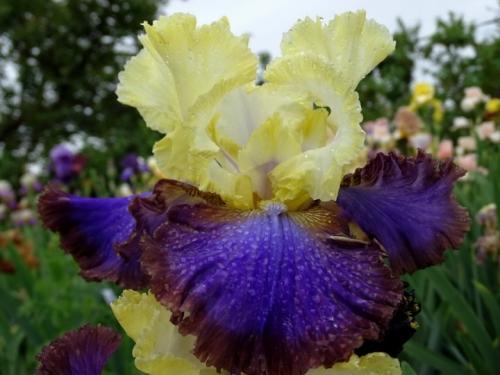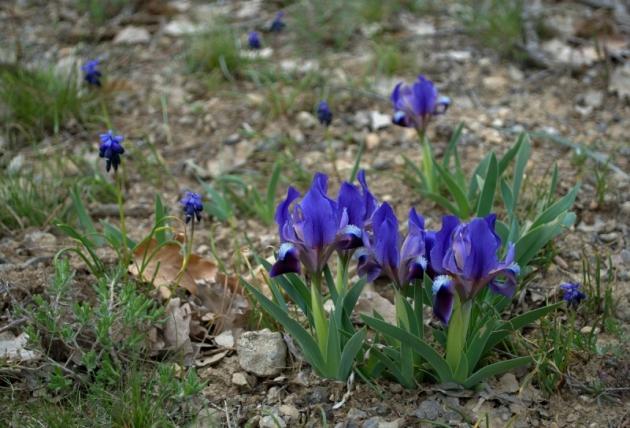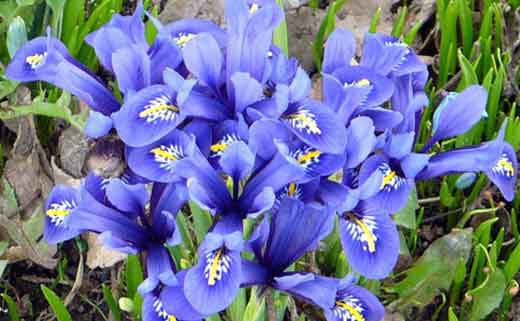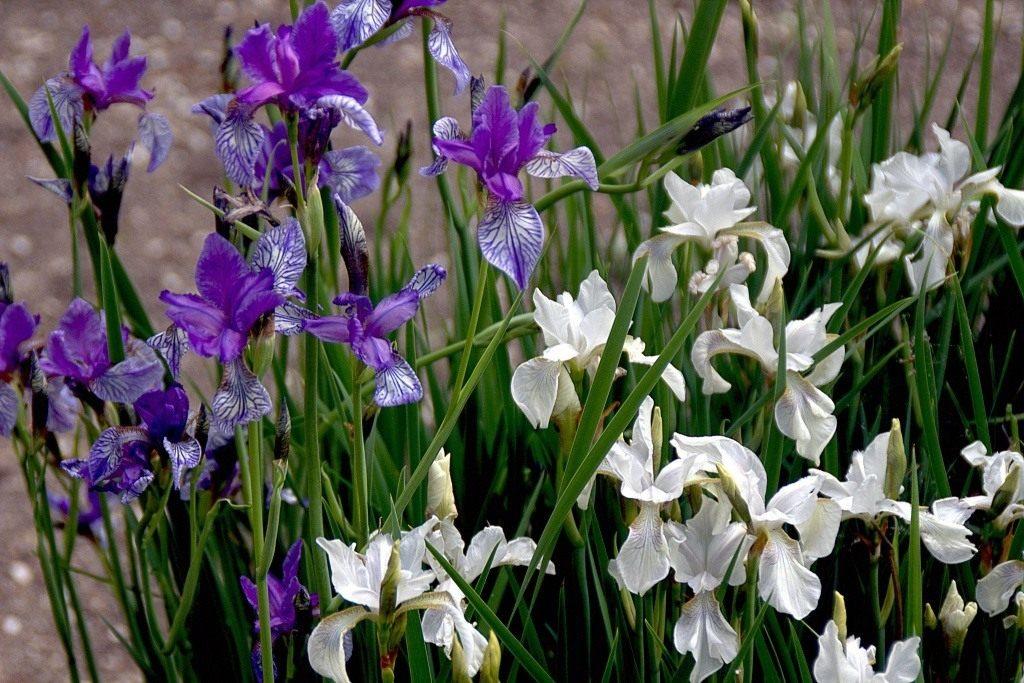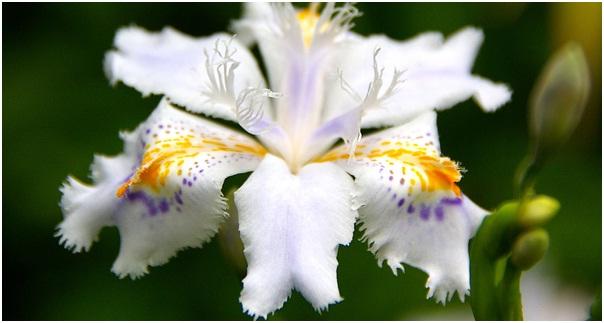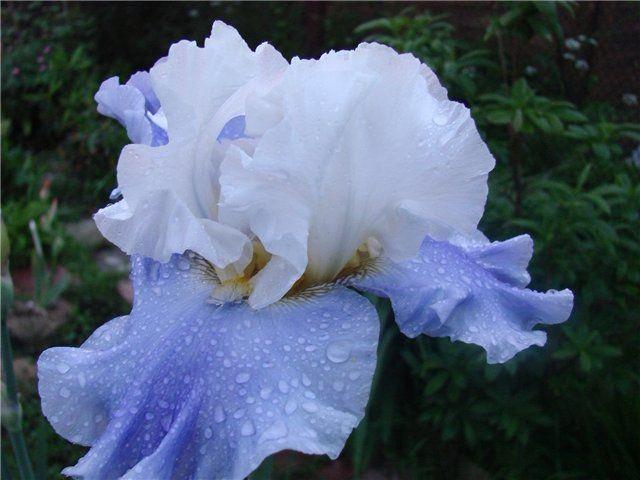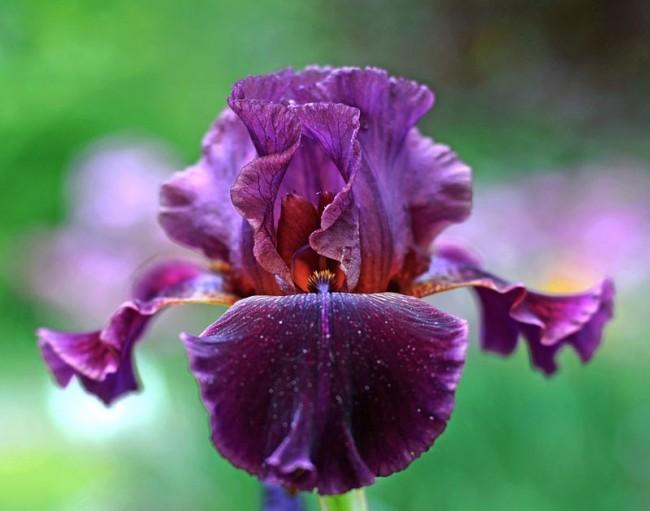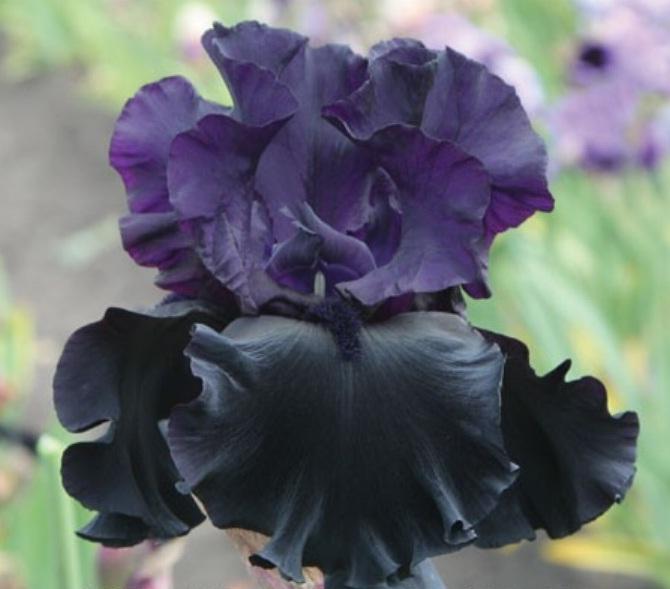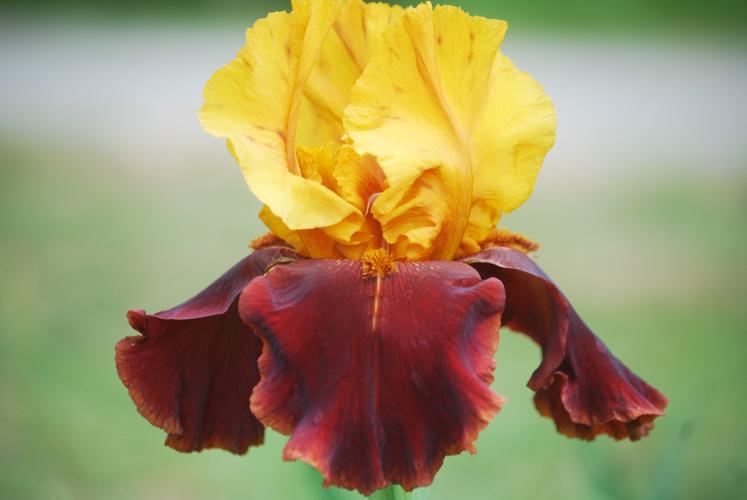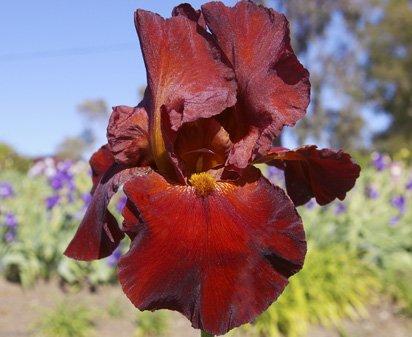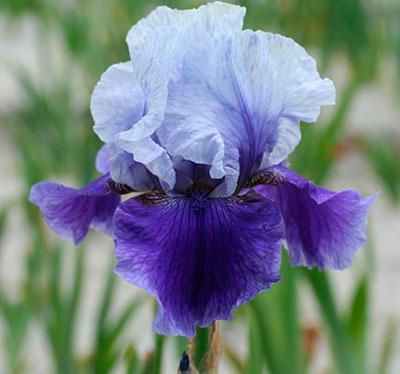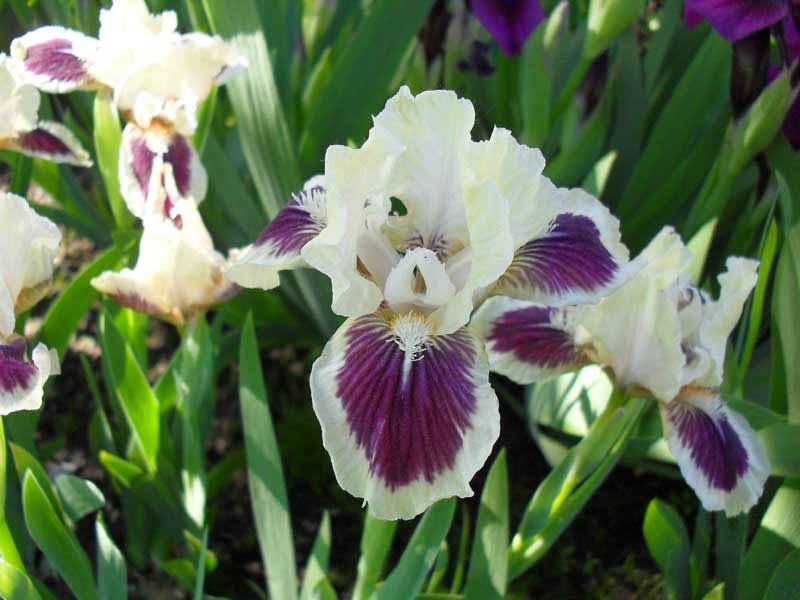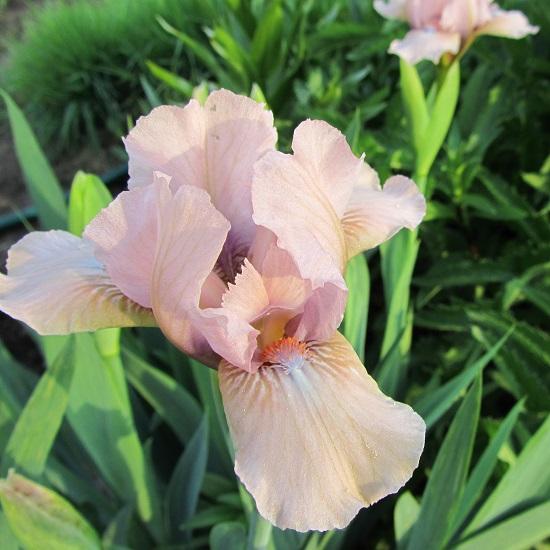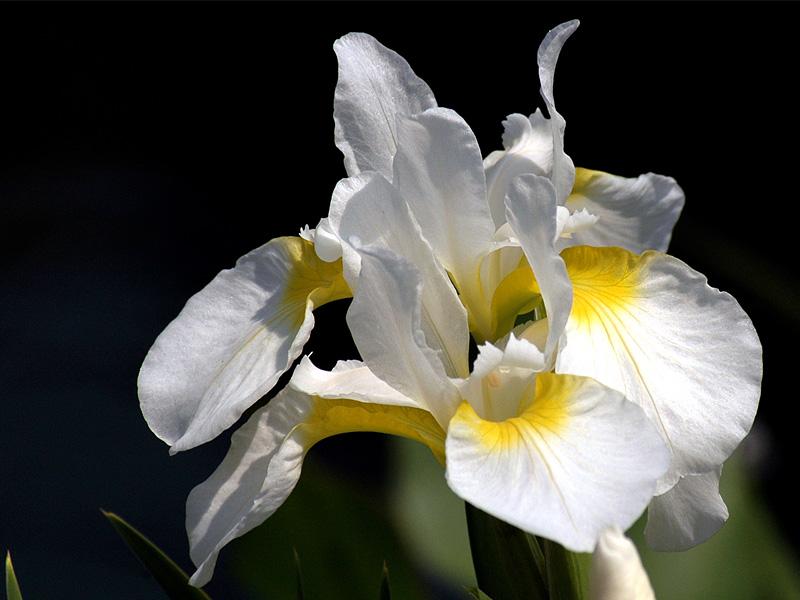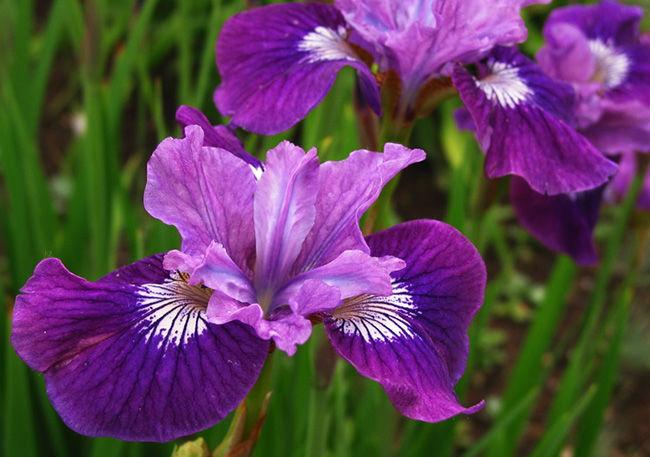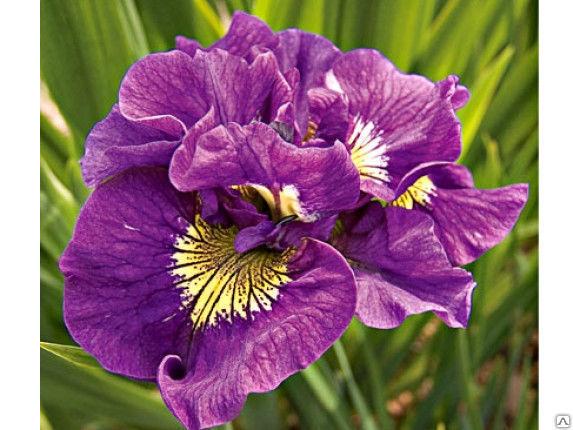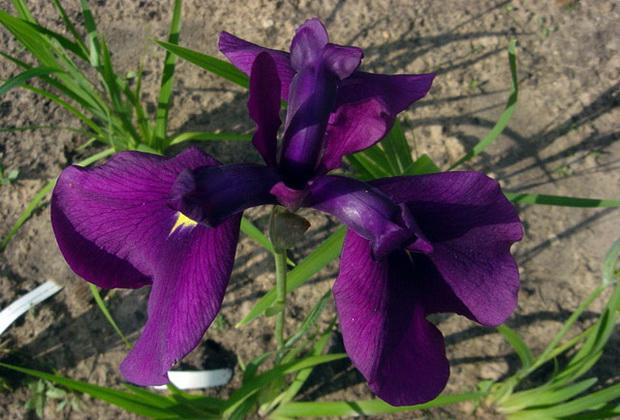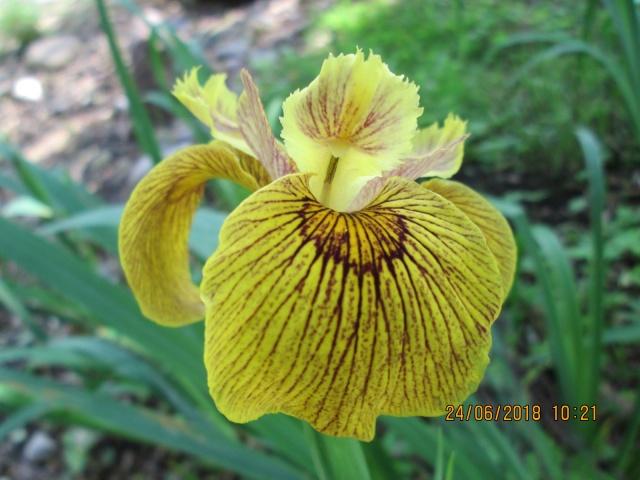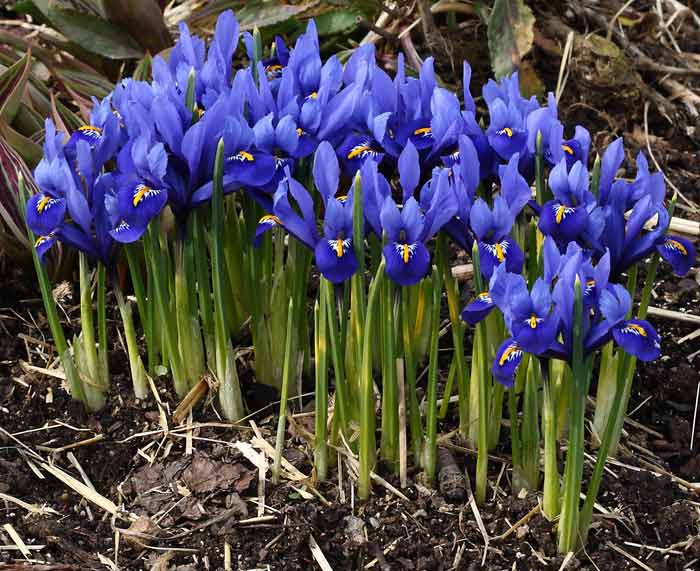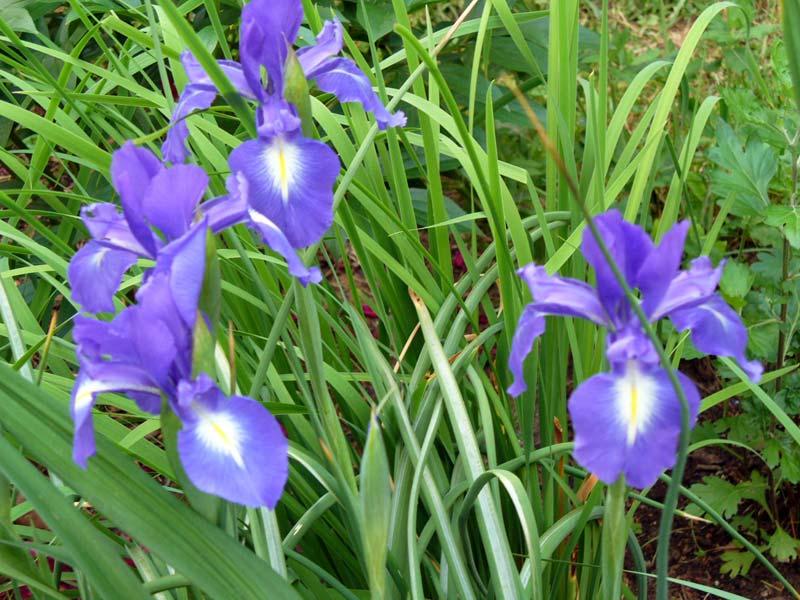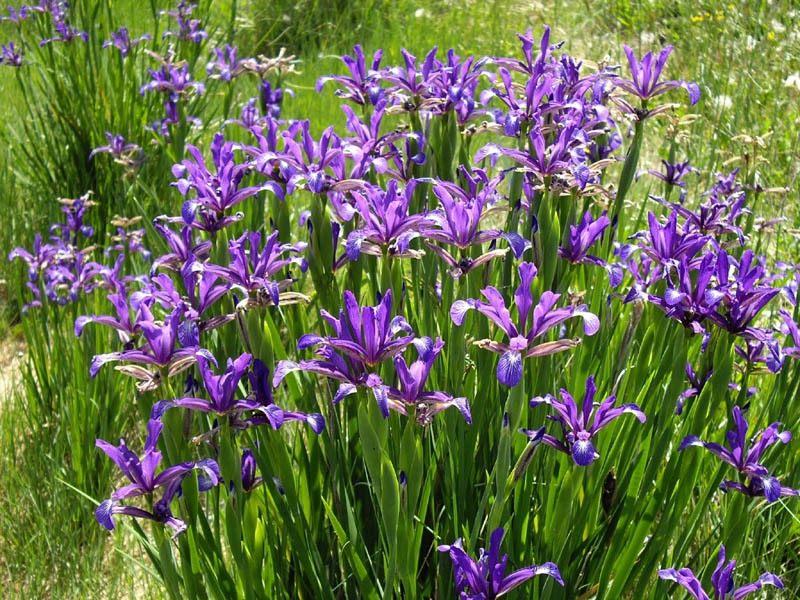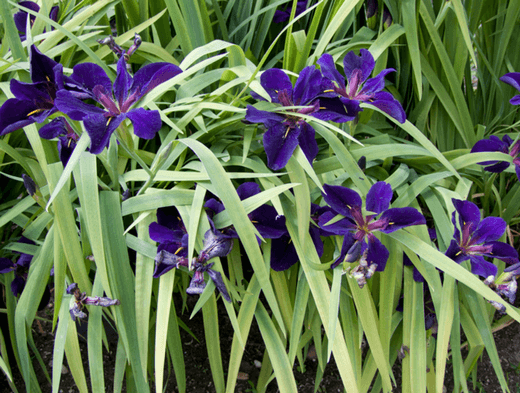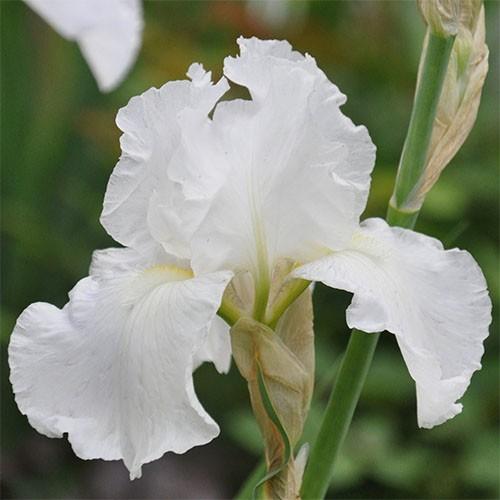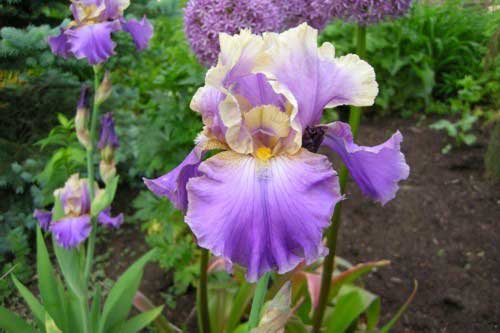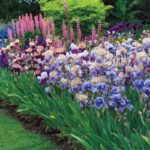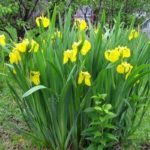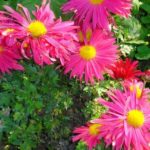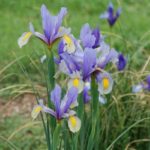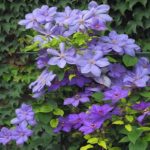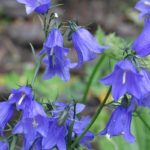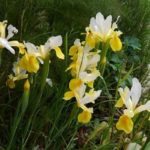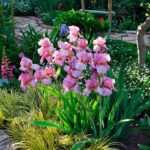It is difficult to find a summer cottage where irises do not grow. Expressive lush greenery, flowers of exquisite shapes and colors arouse the universal love of flower growers. They are grown in flower beds and in apartments. Irises are distinguished by their diversity - from low dwarfs 10-40 centimeters, to slender tall giants growing over a meter. Let's consider the main varieties of garden irises - by type, variety, color and shape of flowers.
- Varieties of irises: general summary
- Bearded irises
- Dwarf irises
- Bulbous irises
- Siberian irises
- Swamp irises
- Japanese irises
- Groups of bearded irises by color
- White
- Blue
- Blue
- Purple
- Lilac
- Reds
- Pink
- Yellow
- Orange and brown
- Black
- Varieties of bearded irises by bush height
- Tall bearded irises
- Supreme Sultan
- Thornbird
- Sultan Palace
- Vibrant
- Medium-sized bearded irises
- Blashes
- Realgar
- C.J.
- Dwarf bearded irises
- Black Cherry Dilight
- Doll Die
- Pink Castion
- Popular types of Siberian irises
- The Snow Queen
- Dance, ballerina, dance
- Lady Vanessa
- Double Standard
- Kablue
- Bundle of Joy
- Varieties of Japanese irises
- Kogesho
- Vasily Alferov
- Lion King
- Varieties of water-loving irises
- Berlin Tiger
- Variegata
- Flora Plena
- Varieties of bulbous irises
- Iridodictium
- Xifium
- Juno
- Unusual varieties of irises
- Chrysographs
- Spuria
- Louisiana
- California irises
- Repeat flowering varieties
- Immortality
- Jennifer Rebecca
- Mother Earth
- Harvest of Memories
- Autumn date
Varieties of irises: general summary
Irises are perennial plants, divided into bulbous and rhizomatous. Most species have a delicate aroma, for which they are used in perfumery to obtain essential oil. In nature they grow in the steppes, often found on slopes with rocky soil.
Up to 60 species grow in Russia, the number of garden varieties is in the thousands. The flowers are distinguished by their large size and exquisite shape, the colors are varied, for which the plant is called “iris” - rainbow, translated from Greek.
Plants are classified according to flowering time, flower shape, stem height and other characteristics.
The most significant characteristic is the presence of hairs on the outer perianth. According to the international classification, irises are divided into 15 classes. Let's look at the most popular and decorative ones.
Bearded irises
The pubescence of the outer perianth lobe is the main feature of these flowers. This large group includes 8 classes out of 15.These flowers look wonderful in flower beds and in bouquets. Tall species grow over a meter, the inflorescence bears up to 12 buds.
An undoubted advantage for growing in Russia is its frost resistance - the plants do not need to be covered for the winter, they multiply quickly and are resistant to pests. The most decorative varieties:
- Supreme Sultan;
- Sultan Palace;
- Visor;
- Champagne Waltz.
Multi-colored, with delicate carved edges, a strong pleasant smell - bearded men are especially loved by flower growers.
Dwarf irises
Cute dwarfs are a godsend for small flower beds and lawns. The main difference is the decorative variegated foliage, which can decorate the area after flowering all season. One plant often has 2-3 peduncles. The bushes do not grow higher than 40 centimeters, often even shorter - about 20.
The flowers are decorative and elegant, like those of their tall relatives. Some varieties are frost-resistant and unpretentious; there are plants that require special care. Popular varieties of dwarfs:
- Tinker Bell;
- Puppet;
- Sapphire Jam;
- Carat;
- Dark Over.
Low plants are planted along the edges of flower beds, choosing varieties that are harmonious in color.
Bulbous irises
Most types of irises have a spreading rhizome; bulbous varieties are isolated separately in Holland. By purchasing Dutch bulbs, you can grow a wonderfully beautiful plant in the open ground and at home, in a flowerpot.
About 800 varieties are known. The most popular are the following:
- Alida;
- Katharine Hodkin;
- Dunford;
- Pauline.
To get beautiful flowers, you need to carefully select the bulbs and purchase them from trusted suppliers.
Siberian irises
A separate class of irises that have a hollow stem and triangular-shaped stigmas. Belonging to the non-bearded group, these species are the most common in nature.
They differ from other irises in the smaller size of the flowers and the large number (up to 40) buds on the peduncle. Some varieties bloom for up to a month. The best representatives of the group:
- Alba;
- Big Ben;
- Super Ego;
- Double Standard.
Siberian varieties are resistant to weather fluctuations and unpretentious.
Swamp irises
Swamp varieties came to gardeners from ponds and wetlands, but the plants develop well on lawns with moist soil and high groundwater levels. With good and regular watering, the flowers are lush and bright.
Swamp irises will decorate the shore of a natural reservoir or the edge of an artificial one near the house. The best varieties:
- Bastard;
- Kurlen;
- Roy Davidson;
- Holden Clough.
Bearded irises reproduce well near water, decorating the shore of a reservoir with a picturesque group.
Japanese irises
Japanese irises They are distinguished by an almost horizontal position of the petals, increasing the size of the flower. The rosettes are very open, diameter is 15-25 centimeters. Bred for humid climates, so they grow well near bodies of water and require frequent watering.
Among the best varieties are Lilac Haze, Vasily Alferov, Kogesho.
Advice: Japanese species do not tolerate excess calcium in the soil and require high soil moisture.
Groups of bearded irises by color
Bearded irises - the largest and most beloved group of garden flowers. Based on color, they are divided into several main groups:
- single-color - all the colors of the rainbow and even more;
- two-tone - one color, with shade options;
- two-color - bottom and top of different colors.
The color of the neglect also stands out - a complex combination of blue-violet shades.
White
White irises are a rarity in our flower beds. Snow-white petals sometimes have small inclusions at the core of a bright tone, enlivening the flowers.Famous varieties are White Nights, Bianca, Immortality, Snowflake Lacey, Lady Snowflake.
Blue
Irises the color of the sky are frequent guests of flower beds. Breeders spend a lot of effort to get blue roses or gladioli, and there are many varieties of blue irises.
Blue irises are distinguished by tenderness and sophistication; they are planted next to blue or purple flowers, creating wonderful combinations. The best varieties are Divine Duchess, Lake Placid, Superman.
Blue
Bright and cool blue flowers are noticeable in any flower garden; they look impressive in a bouquet. Blue irises are not uncommon; the most favorite varieties are Honky Tonk Blues, Dusky Challenger, Victoria Falls, Sapphire Dawn.
Purple
Irises of purple shades are usually combined with delicate flowers of white and pink tones to dilute the intensity of their color. The best purple hybrids are Explosive, Lady Vanessa, Smile, Cupid-Father.
Lilac
The delicate color of lilac is loved by most summer residents. These irises pair well with light and purple flowers. A good choice is Attention, Mriya, Super Model.
Reds
Red flowers always especially attract attention, standing out against the greenery. Popular red irises include New Centurion, Play with Fire, and Rhett.
Pink
The most delicate flowers of pink and apricot shades do not stand out so brightly in flower beds, but they look wonderful in bouquets and apartments. They are best viewed from close up to enjoy all the nuances of the colors. Representatives - Windsor Rose, Pretty Pink, Lace and Ruffles.
Yellow
Yellow irises look harmonious against the background of greenery, cheerful and bright. They lift the spirits with their sunny colors - Martile Rowland, Muffin, Autumn Fiesta.
Orange and brown
Warm colors are loved by all gardeners.In combination with cold ones, they create multi-colored flowers in flower beds and delight with exquisite combinations. The best hybrids with shades of orange and brown are Brown Lasso, Sunset in Avalon, Silkirim, Player.
Black
Many people love the gloominess of dark shades of irises among the bright greenery of the garden. Gothic lovers should pay attention to the varieties - Before the Storm, Night Game, Black Dragon.
Varieties of bearded irises by bush height
The height of the peduncle is one of the main characteristics of the variety, which is taken into account when planting in order to create harmonious flower beds. This indicator is also important for the use of cut flowers.
Tall bearded irises
Tall varieties include plants with stems longer than 70 centimeters; the tallest ones grow up to 120 centimeters.
Thanks to their dense stems, irises proudly bear their beautiful heads and stand beautifully in bouquets.
Supreme Sultan
The flower stands out with its bright, noble appearance in any area, and is beloved by flower growers. The diameter of the flower is 15-20 centimeters. The upper part is an intense yellow-orange color, the lowered petals are dark burgundy.
The peduncle contains up to 7 flowers, the stem grows up to 90 centimeters. Due to its good winter hardiness, it is grown everywhere in Russia.
Thornbird
The iris is a noble cream shade and has the shape of an orchid. The fouls are mustard-colored with green. The peduncle stretches up to 0.8 meters, blooms abundantly in June-July. Tolerates the weather conditions of the Middle Zone well.
Sultan Palace
The beauty of any flower garden is a distinct red color with veins of a different tone. The beard is yellow. The petals are slightly corrugated along the edge. Grows up to 15 centimeters in diameter. Stem - up to a meter. Blooms for a long time, winter-hardy.
Vibrant
Lush corrugated flowers of yellow Vibrant are visible in any flower bed.This iris is hard to miss. The color is intense golden, the petals are dense. The stem reaches 85 centimeters, the quality of the flowers does not deteriorate for many years.
Medium-sized bearded irises
Irises with medium-sized stems tolerate frost better and show greater resistance to bacteriosis than tall plants. There are many wonderful varieties among medium-sized irises.
Blashes
Germanic iris combines two colors - blue and blue-violet. The pale blue upper petals have dark veins. It grows up to 65 centimeters, is unpretentious and frost-resistant.
Realgar
The flowers reach 12 centimeters in diameter. The top of the flower is a pronounced yellow color. The lower petals have a complex color - white stripes run along a muted crimson background. Used to decorate borders.
C.J.
The snow-white petals of the iris are edged with a blue-blue border. The flower is lush and airy at the same time, diameter is up to 12 centimeters. The stem is medium-sized - 60 centimeters. Blooms in late May-June.
Dwarf bearded irises
Dwarf bearded irises are second only to tall irises in stem size. The size of the flowers and the sophistication of the colors of short bearded irises do not differ from ordinary ones.
Black Cherry Dilight
One of the shortest varieties with a stem 15 centimeters long. The peduncle bears one flower - the petals are white-cream, with faint veins, on the lower ones there is a purple spot in the center.
Doll Die
The exquisite flowers of the dwarf iris are reminiscent of daffodils in color - white-yellow, cheerful, spring. The beard flower has a lilac hue and is refreshing. Bearded dwarf blooms in May-June.
Pink Castion
The bush grows up to 20 centimeters. The flowers are soft pink, with slightly double petals.The beard has a darker pink color.
Popular types of Siberian irises
The large group of Siberian irises includes more than 800 hybrids. They are a beardless species and have smooth, dense petals.
Information: Siberian irises fully confirm their name - they are unpretentious and tolerate frost well.
The Snow Queen
An original flower with narrow petals of snow-white color. The petioles are colored lemon yellow. The flower is delicate and airy. The foliage is narrow, curved in a thin arc. The bush reaches 90 centimeters.
Dance, ballerina, dance
The lower petals look like a tutu, the upper ones, according to tradition, are raised up, pale pink. The color of the lower petals is brighter, pink-lilac, with small dashed lines of an even darker tone closer to the center. Stem – 80 centimeters.
Lady Vanessa
The Lady Vanessa variety has collected several shades of blue-violet color. The lower petals are wide open, of a pronounced bluish-lilac tone with white, streaked spots in the center. The central petals are lighter and thinner. The bushes are massive and tall.
Double Standard
Belongs to terry varieties, the number of petals is 6-12. The flower is a juicy blue-violet color - lush and large. The lower petals have beautiful yellow spots with streaks. The plant is tall and stable, with up to 5 flowers on the peduncle, blooming together.
Kablue
It blooms in May and pleases the eye with a long flowering period lasting 3-4 weeks. The flowers are large, densely double. The number of petals is more than 18. It has a rich blue-violet color, the lower petals with yellow-orange spots.
Bundle of Joy
A favorite of summer residents, it has packed flowers in a purple-pink hue. The lower petals are horizontal, with blue signals.The stem grows up to 70-90 centimeters, dense and stable.
Varieties of Japanese irises
Japanese varieties of irises have large flowers and expressive greenery. There are 3-5 flowers in the inflorescence, the total flowering time is about 3 weeks.
Kogesho
The most beautiful representative of Japanese varieties. A flower of exquisite shape - with a strongly open rosette. The petals are snow-white with lilac-purple veins and delicate yellow strokes in the center. The dense, stable stem grows over a meter.
Vasily Alferov
The peduncle of this variety rises to 110 centimeters, bears purple flowers with small bright spots of yellow. The lower petals are large, slightly downward.
Lion King
A flower of an unusual shape with narrow petals of a bizarre appearance. The color of the petals combines several warm shades - yellow, bronze, lilac-brown. The lower petals are densely shaded. Iris grows up to 75 centimeters.
Varieties of water-loving irises
The best place for planting these species is the banks of reservoirs, where the plants grow quickly and bloom profusely. In the absence of shallow water, they require acidic soils and abundant watering.
Berlin Tiger
The iris has a tiger coloring - thick red-brown shading on a yellow background. The petals are not wide, lowered down. The flower is small - 10 centimeters on a stem 70 centimeters high.
Variegata
The decorative effect of this iris is ensured by its lush, bright foliage, which retains its shape even after flowering. The flowers are yellow and small, hiding among the greenery. Only good in a flower bed.
Flora Plena
A double variety of swamp iris of bright yellow color. On the lower petals there are small brown spots in the form of faint stripes. The flower is delicate and decorative, blooms in June.
Varieties of bulbous irises
Domestic breeders do not classify bulbous species as a separate class. The main producer of bulbous varieties is Holland, supplying its irises to all countries. There are three main classes of bulbous crops.
Iridodictium
Short bulbous irises sometimes called snowdrops for their early flowering. The foliage and flower stalks grow together as soon as the snow melts. Peduncles do not grow higher than 15-20 centimeters, but leaves can grow up to 50. The flowers are delicate, one per peduncle. The most popular species are Dunford (yellow), reticulated Iridodictium (purple), Pauline.
Xifium
For many years in our country they were grown only in apartments, as a potted crop. The main difference is the increased requirements for sunlight. The stem grows up to 60 centimeters. For the winter, the bulbs are dug up and stored in a cool, dark place. The best varieties are Symphony (delicate white-orange flowers with thin petals), France Halls, Wedgwood, Ideal, Yellow Queen, Emperor.
Juno
Refers to the most original types of irises. The stem is dense, with leaves. The flowers have a special structure; their color is white, blue, yellow and orange. Plants are usually short, rarely growing up to 50 centimeters. They usually bloom early - mid-spring.
Unusual varieties of irises
Irises obtained by interspecific crossing are sometimes difficult to classify into specific groups. They stand apart, have an unusual appearance, often resemble orchids or other flowers and bear little resemblance to the usual irises.
Chrysographs
A little-known variety of irises, they are bred in China. Chrysographs are not distinguished by dense, abundant foliage; the bushes fall apart, are loose and loose.Flowers have graceful narrow petals with streaks and spots at the bottom. These varieties rarely come to market, so you rarely see them in flower beds.
Spuria
A little-known species of spuria is rarely found in our flower beds. The flowers are similar in shape to orchids, with the lower petals narrower than most irises. Each flower lasts up to a week, the entire plant blooms for several weeks. The varieties Golden Lady, Sultan’s Sash, and Imperial Bronze are popular in Russia.
Louisiana
US breeders are working on species of Louisiana irises that are rare in the eastern hemisphere. They are found only in botanical gardens, as they require special conditions. In the USA, these varieties are used for planting near bodies of water.
Well-known varieties include Longue Vue (white-cream), Classic Note (yellow-orange), Ice Angel (blue).
California irises
Natural species of irises come from the Pacific Ocean. Grows well in acidic soils. The flowers are small and not particularly decorative. It is difficult to reproduce, so they are not widely spread. The bush is evergreen, with narrow glossy foliage. Siberian-California hybrids are more common, free from most of the problems of purely Californian irises.
Repeat flowering varieties
Some varieties of irises grown in warm regions with long summers are capable of blooming twice per season. They are called rebloms or remontants. In August-September they throw out a peduncle for the second time during the season and delight with another flowering.
Immortality
The Immortality variety is classified as remontant. The iris blooms for the first time in May, and re-blooms with timely feeding in August-September. The flowers are white, large, the beard is yellow.
Jennifer Rebecca
Exquisite large pink flowers with fringed petals. The beard is orange. The stem rises up to 80 centimeters, stable and strong.
Mother Earth
The petals are lilac-pink in color, the lower ones are brighter in color. Small splashes of yellow are in the center of the petals and on the beard. The peduncle bears up to 9 buds. It blooms in June, the stem is tall - 90 centimeters.
Harvest of Memories
A single-color flower of muted yellow color. Grows on a tall stem. Blooms again in August. The foliage has a waxy coating, the rosette is dense, the leaf is narrow and xiphoid.
Autumn date
The white petals of the flowers are densely covered with dusting and strokes of a blue-lilac hue. The overall impression is a bluish-violet iris. It almost always blooms again.
Irises are favorites of landscape designers and flower growers. By choosing the right varieties for the flowerbed, you can achieve a long flowering group. Greenery of many varieties remains decorative throughout most of the summer. Alpine hills are decorated with flowers and grown in flowerpots and on window sills. Irises are used to create bouquets that will delight you with their exquisite beauty for a long time.

